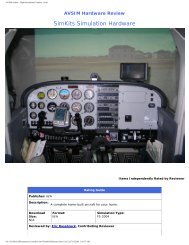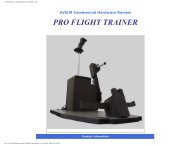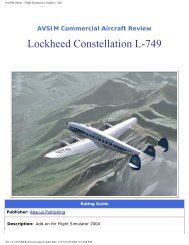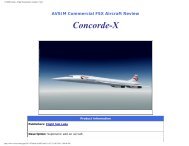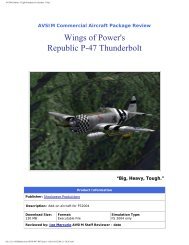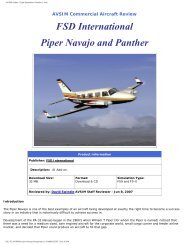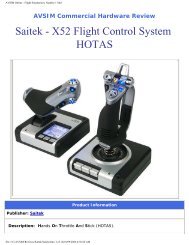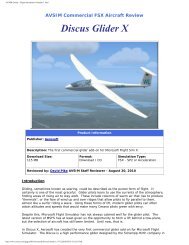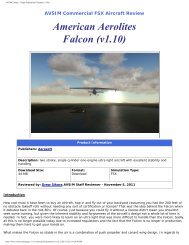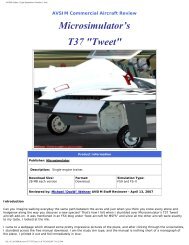AVSIM Online - Flight Simulation's Number 1 Site!
AVSIM Online - Flight Simulation's Number 1 Site!
AVSIM Online - Flight Simulation's Number 1 Site!
You also want an ePaper? Increase the reach of your titles
YUMPU automatically turns print PDFs into web optimized ePapers that Google loves.
<strong>AVSIM</strong> <strong>Online</strong> - <strong>Flight</strong> <strong>Simulation's</strong> <strong>Number</strong> 1 <strong>Site</strong>!<br />
Publisher: JDT LLC<br />
<strong>AVSIM</strong> Commercial Utility Review<br />
Radar Contact Version 4.01<br />
Product Information<br />
Description: Realistic Air Traffic Control Services for Microsoft <strong>Flight</strong> Simulator<br />
Download Size:<br />
N/A<br />
Format:<br />
CD ROM<br />
file:///E|/<strong>AVSIM</strong>/Reviews/RC4/RC4.htm (1 of 19)10/02/2006 2:33:35 PM<br />
Simulation Type:<br />
FS98, FS2000, FS2002, FS2004
<strong>AVSIM</strong> <strong>Online</strong> - <strong>Flight</strong> <strong>Simulation's</strong> <strong>Number</strong> 1 <strong>Site</strong>!<br />
Reviewed by: Michael "Mike T" Toussaint <strong>AVSIM</strong> Staff Reviewer<br />
Introduction<br />
Air Traffic Control (ATC) in relation to Microsoft <strong>Flight</strong> Simulator really presented itself in<br />
earnest with the release of the add-on title Proflight. First released for MSFS 98, Proflight<br />
became the standard by which all available ATC titles were judged. Proflight was<br />
immersive, accurate and a relatively credible representation of ATC. Essentially, Proflight<br />
opened up a whole new world for <strong>Flight</strong> Simulator fans. Even with a lack of “real” traffic<br />
within the simulator, Proflight provided chatter and distinct accented voices to guide one’s<br />
aircraft around the <strong>Flight</strong> Sim world. Despite any perceived limitations, it was quite an<br />
advance to the immersion factor of flying the virtual skies and flying within MSFS without<br />
ATC was no longer an option.<br />
As we fast forward to MSFS 2002 and FS 2004, Microsoft included a built in ATC engine<br />
that made Proflight obsolete. There was no longer a need to generate a static adventure to<br />
enjoy ATC services because the ATC within MSFS 2002 was dynamic and gave the virtual<br />
pilot some capability of changing a currently engaged flight plan on the fly. Additionally,<br />
MSFS introduced something else that would change the flight simulator world, Artificial<br />
Intelligence (AI) traffic. Not only did the virtual pilot have the ability to contact ATC at will,<br />
but ATC interacted with the AI aircraft thereby putting forth a fluid and realistic<br />
environment in which to interact.<br />
Despite the leap forward in the interactivity of ATC and AI within <strong>Flight</strong> Simulator, there<br />
were some significant drawbacks. For instance, the ATC included in FS 2002 / FS 2004 is<br />
very simplistic. Sure it can direct one’s aircraft from point A to point B, but many in depth<br />
ATC procedures, such as SIDs, STARs, Holding, Diversions, Emergencies, etc were<br />
obviously missing. Additionally, a major sore point of the default ATC is and always has<br />
been, its inability to effectively corral the AI traffic once within the terminal airspace. It is<br />
very common for sim pilots to be assaulted by AI aircraft while on final approach.<br />
Similarly, the AI aircraft have a nasty tendency to arrive in clusters, thereby causing<br />
unrealistic numbers of go-arounds, especially at large airports. But, at the end of the day,<br />
I would surmise that 99% of us use or have used the default ATC in one form or another<br />
and I would go even further to guess that 90% of us still use the default ATC today<br />
despite its glaring drawbacks. The fact is that it really does a credible job, it is convenient,<br />
and it is tightly integrated into FS 2002 / 2004.<br />
In parallel with the default ATC, there have been two other much more realistic choices for<br />
ATC. The first, on-line ATC. Free services provided by VATSIM and IVAO (and others) have<br />
existed in one form or another since before FS 98. I can remember my first “on-line” Fly-in<br />
where the ATC was provided via telephone. Once I arrived at my designated waypoint, I<br />
actually called someone who gave me ATC instructions, by phone, all the way to landing!<br />
Today’s on-line ATC is highly sophisticated and realistic. Voice Over IP (VoIP) is used for<br />
file:///E|/<strong>AVSIM</strong>/Reviews/RC4/RC4.htm (2 of 19)10/02/2006 2:33:35 PM
<strong>AVSIM</strong> <strong>Online</strong> - <strong>Flight</strong> <strong>Simulation's</strong> <strong>Number</strong> 1 <strong>Site</strong>!<br />
real-time voice communications with pilots which are guided, as in real life, by a controller<br />
looking at a radar panel and viewing aircraft in his/her sector in real-time. The ATC staff is<br />
trained and presents the most realistic interface for the flight simmer to date. All other<br />
virtual aircraft are manned by live pilots and the immersion factor can be uncannily as<br />
hectic as real flying. This is especially true on “Fly-In” days, where literally hundreds of<br />
pilots converge at one airport from all over the world.<br />
Of course, there is a downside to on-line ATC and the downside in this case is very large.<br />
One will find that to have a totally realistic flight from point A to point B, one has to<br />
confine oneself to the areas where ATC is currently online. I doubt if there ever was a time<br />
where there has been global ATC online at the same time. This means that it is not<br />
uncommon for one to contact Center, for clearance delivery, ground and departure. Once<br />
out of range, you can easily find yourself out of contact with ATC for the duration of your<br />
flight or for hours between areas of live ATC. Additionally, online ATC means you have no<br />
AI traffic because you cannot fly on-line and have AI traffic at the same time. This fact<br />
means that flying online can be very lonely and it is absolutely not uncommon, especially<br />
for long haul pilots, to fly for hours without seeing or hearing from another airplane or<br />
controller and landing with no ATC at a desolate major airport totally devoid of traffic.<br />
While the premise of online ATC is extremely attractive, I have yet to see it implemented<br />
in such a way that offers consistent global service. I definitely liken online ATC to the “little<br />
girl with the little curl right in the middle of her forehead”. “When she was good she was<br />
very, very, good but when she was bad, she was horrid!”<br />
The second choice for the virtual pilot is Radar Contact (RC). Developed by JDT LLC, Radar<br />
Contact became an alternative to Proflight. Radar Contact Version 3.x was released as an<br />
alternative to fill the realism gaps presented in the default MSFS ATC engine and did an<br />
excellent job. Developed by individuals with intimate knowledge of ATC procedures and a<br />
burning desire to thrust the avid virtual pilot into a much more realistic ATC environment,<br />
RC 3.x provided point-to-point procedural accuracy which was unsurpassed without being<br />
online. RC 3.x presented the hyper-accurate ATC jargon presented in live online ATC<br />
environments without the large gaps in coverage. Additionally, usage of RC 3 meant that<br />
one had the crowded AI skies that the majority of virtual pilots demand.<br />
Of course, nothing is perfect. RC 3.x did not control the AI traffic and that task was left to<br />
the default ATC engine. Secondly, since RC 3.x did not interact with any AI aircraft, nor did<br />
it have the ability to generate dynamic chatter that was relevant to the flight environment.<br />
Instead, RC 3.x utilized the old “canned” chatter circa Proflight.<br />
It has never been a secret that the crew at JDT was working on the next generation RC<br />
product, RC 4. Promised in RC 4 were many enhancements not available in its predecessor<br />
or the default ATC, and, not least of these new features, is the management of AI traffic.<br />
The prospect of RC 4 excited me but since I'm always the cynical skeptic, I took a waitand-see<br />
attitude. While the thought of having the best of online flying with the immersion<br />
surpassing that of the default ATC is extremely attractive, I was still reluctant to give up<br />
the ease of use of my old friend. So, excitedly and without further ado, I present to you,<br />
file:///E|/<strong>AVSIM</strong>/Reviews/RC4/RC4.htm (3 of 19)10/02/2006 2:33:35 PM
<strong>AVSIM</strong> <strong>Online</strong> - <strong>Flight</strong> <strong>Simulation's</strong> <strong>Number</strong> 1 <strong>Site</strong>!<br />
JDT LLC’s latest release: Radar Contact 4.01.<br />
Purchasing and Installation<br />
The <strong>Flight</strong> Simulator add-on market has decidedly become a “pay now, download now”<br />
market, and as such we are all accustomed to flashing our credit card and minutes later<br />
playing with our new toy. This instant gratification has undoubtedly spoiled us all.<br />
Before I go any further, I will divulge that RC 4 is available by DISK ONLY. Yes, you pay<br />
now and days later a CD arrives at your door. I have seen many pleadings on the RC<br />
forum (exclusively here at Avsim) begging the developers to make the title available by<br />
download. The size of the program is not out of the realm of “downloadability” because<br />
files in excess of 1 Gigabyte have been made available for download by other developers.<br />
The fact that RC 4 comes on only one CD ensures that the files total no more than 700Mb.<br />
In my opinion, this file size well within the realm of being made available for download.<br />
Test System<br />
AMD FX-57<br />
1GB Hyper-X PC3200 DDR<br />
X850XT PE Video<br />
Audigy2 5.1 Surround<br />
Insignia 26” 16:9 Monitor<br />
Logitech 5.1 THX Speakers<br />
NGO ATI 1.5.13 Drivers<br />
Reserator Liquid Cooling<br />
Flying Time:<br />
45+ hours<br />
However, I will not dispute the wisdom of the developer’s<br />
choice to make the title available via CD only. I am sure<br />
they have their reasons from a business standpoint and<br />
those reasons will not be debated here.<br />
The good news is that the choice to release via CD by mail<br />
does teach us decidedly impatient simmers a little<br />
patience and builds the “I can’t wait for the mail”<br />
anticipation. The question being, is RC 4 worth the wait?<br />
Read on!<br />
Documentation is included on the installation CD in .PDF<br />
(Adobe Acrobat) format, and what documentation it is!<br />
The crew at JDT illustrates the use of RC 4 in great detail<br />
and left nothing to chance. Everything one would ever<br />
want to know about the effective use of RC 4 is pointed out en masse. Additionally, the<br />
developer understood that not everyone who will purchase the product comes with a<br />
standing knowledge of ATC procedures and lingo, therefore they have included a tutorial of<br />
everything from controlled airspace to the phonetic alphabet.<br />
I suggest that you read the 294 page manual. It will make the use of RC much more<br />
enjoyable especially if one is new to the world of realistic ATC.<br />
Installation of RC 4 is straight forward and offers some installation options: You can install<br />
the full RC 4 package complete with “canned chatter” files, or tou can dispense with the<br />
“canned chatter” and rely on the AI traffic to generate real time chatter. I chose to save<br />
the hard drive space and install all but the chatter files. With AI interoperability, I knew<br />
that I would never use the canned chatter anyway.<br />
Interestingly enough RC 4 is totally backward compatible all the way back to FS 98! During<br />
file:///E|/<strong>AVSIM</strong>/Reviews/RC4/RC4.htm (4 of 19)10/02/2006 2:33:35 PM
<strong>AVSIM</strong> <strong>Online</strong> - <strong>Flight</strong> <strong>Simulation's</strong> <strong>Number</strong> 1 <strong>Site</strong>!<br />
the installation you can chose your version of MSFS and the installation is automatic from<br />
that point. RC4, by default, installs the latest version of FSUIPC and ADVDISP and this<br />
cannot be changed.<br />
The installation went smoothly and soon I was ready to familiarize myself with RC4. Once<br />
installed, it is necessary to activate RC by emailing the code which is generated upon<br />
installation to the support team and wait for a return email before you can use RC. In my<br />
case it took approximately 48 hours to receive my code because I believe that my spam<br />
blocker intercepted my registration email. Luckily RC is supported by a crack staff of<br />
dedicated individuals on its forum and my problem was resolved almost instantly. Still, the<br />
prospect of email registration for a major release such as RC is archaic. With tools such as<br />
the <strong>Flight</strong> 1 wrapper available for instant online registration I would like to see JDT move<br />
to a more up-to-date method of getting their customers up and running. Granted, my<br />
experience is probably not typical, but with the prevalence of email filters and the longer<br />
turn-around time already exacerbated by the need to wait for the CD to arrive, I suspect<br />
more then one frustrated customer may complain at the lag between paying for and using<br />
the product.<br />
Finally, with the product received, registered and installed, those of you who have read my<br />
previous reviews know by now that I don’t let any title off with the gratuitous test flight<br />
around the pattern. Any title that is presented to me for review must stand up to grueling<br />
real flights in MSFS 2004. The fact that I exclusively fly heavy iron on long haul flights also<br />
means that the title is coming along for at least an eight hour one way flight (I always fly<br />
round trip). In this case, wanderlust got a hold of me and I felt the need to fly from<br />
Chicago O’Hare to Tokyo Narita, and back. After that, I decided upon a leisurely jaunt to<br />
Paris Charles De Gaulle and back from Chicago O’Hare. With flight plans totaling over 30<br />
hours in real time (no acceleration) I planned to learn everything there is to know about<br />
RC 4 and uncover all of its weaknesses as well as its strong points.<br />
Radar Contact 4 vs 4.01<br />
This review is based on Radar Contact 4.01. JD was kind enough to submit the patch to<br />
me prior to the completion of the review. Since 4.01 will be available to the general public<br />
within a matter of days (by the time you read this review you should be using v4.01) I<br />
thought it only fair that the review be based on the most current available version.<br />
Some of the fixes in RC 4.01 are:<br />
- New method of "weaving" the WAVS together. The Old method was to play the files<br />
individually. The new method concatenates all files to be played into one file, and playing<br />
the new file.<br />
- Japanese, Korean, Chinese versions of Windows will now run Rcv4.<br />
- "Airport" removed from the non-FAA clearances.<br />
- "Will give him a call" removed.<br />
file:///E|/<strong>AVSIM</strong>/Reviews/RC4/RC4.htm (5 of 19)10/02/2006 2:33:35 PM
<strong>AVSIM</strong> <strong>Online</strong> - <strong>Flight</strong> <strong>Simulation's</strong> <strong>Number</strong> 1 <strong>Site</strong>!<br />
- Other "Doug-isms" removed.<br />
- If rcv4 is not able to write the .rcd file to the \my documents\flight simulator files path<br />
after a save (either user initiated or autosave initiated), if rcv4 doesn't have the necessary<br />
permissions (eliminate run time error 75's hopefully).<br />
- New voices screen, which puts each type of voice on a "tab". Each voice now has a slider<br />
associated with it, to slow it down if it is to fast. also a flag will appear when a voice is<br />
selected, for easier identification.<br />
- Able to read flight plans which have a degree symbol instead of an asterisk in the lat/<br />
long field.<br />
- Fixed the runtime error 9 with RC closing down when you hit a number key not in the<br />
adv display menu.<br />
- Correct entry3, entry2, entry1, downwind, base and final after returning to departure<br />
airport, when the arrival airport has a high MSA.<br />
- If the AI does not have the correct aircraft type, or I don't have the aircraft type defined,<br />
I will not say "follow the" or "give way to the".<br />
- Restore the correct international settings for comma and period, when you click the "Quit<br />
RC" button.<br />
The most obvious and monumental fix is the smoothness of the voices in 4.01 vs. 4. Many<br />
have complained that the voices are too slow. I confirmed that on my first flight without<br />
the 4.01 upgrade. Post upgrade, the voices are extremely fluid and truly mimic what is<br />
heard in the real world. In short, it makes a world of difference to RC experience as a<br />
whole.<br />
One last point before I dig deeper into Radar Contact 4. RC 4 does NOT have the ability to<br />
handle VFR traffic. I think that this is a pretty substantial hole since there is a large portion<br />
of the <strong>Flight</strong> Simulator community that enjoys flying low and slow and by landmark rather<br />
than by Very high frequency Omidirectional Beacons (VOR) or Non-Directional Beacons<br />
(NDB). Alas, those in the community that fly strictly VFR are relegated to using the default<br />
or online ATC services…for now.<br />
Prepare For Departure<br />
Radar Contact is a program that runs in the background while you fly within MSFS. There<br />
is a set procedure for setting up RC prior to starting <strong>Flight</strong> Simulator and it should be<br />
adhered to or there could be anomalies between MSFS and RC.<br />
file:///E|/<strong>AVSIM</strong>/Reviews/RC4/RC4.htm (6 of 19)10/02/2006 2:33:35 PM
<strong>AVSIM</strong> <strong>Online</strong> - <strong>Flight</strong> <strong>Simulation's</strong> <strong>Number</strong> 1 <strong>Site</strong>!<br />
The first thing one must do, is create a flight plan because RC does not include a flight<br />
planner and will not work without one. While there are a multitude of 3rd party flight<br />
planners out there, I have used FSBuild since it was first released. FSBuild allows you to<br />
create a flight plan in many 3rd party add-on formats and, of course, in the default FS<br />
200x format which RC 4 will need to provide ATC services. I imported my flight plan from<br />
O’Hare to Narita and it was quickly displayed in the adjacent window in a format<br />
remincient of the way a pilot would see a flight plan in the real world.<br />
Next, I clicked on the Controller Info button. The General tab allows the pilot to choose<br />
various options regarding the flight. For instance, one can choose the type of departure, i.<br />
e. departure with or without altitude restrictions. If there is a SID (Standard Instrument<br />
Departure) in the flight plan, this option is a must. You can also ask ATC for no speed<br />
restrictions below 10,000 feet, adjust the cruise altitude and enter up to two alternate<br />
arrival airports. There is also a listing of frequencies pertaining to the flight and when you<br />
enter the name of the alternate airports, those fields are populated. NOTAMs (Notice To<br />
Airmen) check boxes are provided in case one is departing from or arriving at an airport<br />
file:///E|/<strong>AVSIM</strong>/Reviews/RC4/RC4.htm (7 of 19)10/02/2006 2:33:35 PM
<strong>AVSIM</strong> <strong>Online</strong> - <strong>Flight</strong> <strong>Simulation's</strong> <strong>Number</strong> 1 <strong>Site</strong>!<br />
that has large obstructions such as mountains in the vicinity. Checking the NOTAM box<br />
gives the pilot flexibility on departure and arrival. Therefore, ATC will never ask the pilot to<br />
descend or level off at an altitude that will cause a collision with the terrain. Finally, one<br />
can specify the departure AND arrival gates so that you can match real world flight<br />
operations.<br />
Once these variables are locked in place, you should click on the General tab to input the<br />
airline and flight number. You can also define if the chance of holding for weather or traffic<br />
is applicable. You are also able to input or check various other options to customize how<br />
RC 4 reacts within MSFS.<br />
Finally, you are able to customize keyboard combinations as necessary, as well as<br />
customize the controller, pilot and copilot voices. RC 4 comes with around 20 voices that<br />
contain different accents; mostly from North America and Europe. There are also new<br />
voices becoming available for download on the RC website.<br />
Once one has set RC up for the first time, it quickly becomes “old hat”. There is nothing<br />
unnecessarily complicated about preparing RC for flight and there are also mouse-over<br />
pop-ups that explain what each checkbox and variable does. I give JDT high marks for<br />
enclosing powerful software innards in an easy to use wrapper. In the same token, the<br />
interface is very simple without any whiz-bang graphics or slick interfaces. In this case, it<br />
may not be pretty but it IS functional.<br />
With RC setup, I loaded FS 2004 and placed myself at gate C-19 at KORD, which I<br />
previously specified within RC. Once FS is up and running, there are a few steps one must<br />
follow to allow RC to display properly within the sim. I clicked ADVDISP from the MODULES<br />
menu bar and spawned the ADVDISP window. Once it is displayed, it should be sized to<br />
about a 2 inch square, so that information from RC is displayed properly. Upon completion,<br />
I minimized MSFS and clicked the START RC button on the main RC interface and ATC<br />
services were now available via the ADVDISP interface.<br />
file:///E|/<strong>AVSIM</strong>/Reviews/RC4/RC4.htm (8 of 19)10/02/2006 2:33:35 PM
<strong>AVSIM</strong> <strong>Online</strong> - <strong>Flight</strong> <strong>Simulation's</strong> <strong>Number</strong> 1 <strong>Site</strong>!<br />
The ADVDISP is the interface from which the virtual pilot interacts with Radar Contact, and<br />
I will say that it is the weak point of RC. Now, please understand that when I say weak, I<br />
do not mean in terms of functionality or usability. I mean in terms of looks. The ADVDISP<br />
has been around since RC 2.x and while it is functional as a way of interacting with RC, it<br />
looks like a DOS command line box. If one is using a 2D cockpit, then it is possible to<br />
“dock” it somewhere on the screen in such a way that it does not stick out like a sore<br />
thumb. However, those of us who only utilize the 3D cockpit, there is no place for the<br />
ADVDISP box to be docked. While it can be opened and closed like the default ATC<br />
onscreen menu, (registered version of FSUIPC required) it is nowhere as pleasing to the<br />
eye as the default onscreen menu. Again, the fact that it is not beautiful but it is functional<br />
does apply.<br />
The last thing to remember on initial setup, is to turn off the default ATC as well as turn<br />
down the ATC volume. If this is not done, then one will get the default ATC as well as RC<br />
coming over the radio.<br />
It's Time To Fly<br />
Sitting in the captain’s seat of United 881 non-stop service to Narita, I went though my<br />
usual aircraft delivery flows and connected power to the 747-400. Assured that my<br />
checklist was over, it was time to get ATIS (Automated Terminal Information Service).<br />
Much as in the default MSFS ATC, Radar Contact uses easy key presses to initiate<br />
communications as needed and in this case I pressed “1” to hear the automated weather.<br />
The voice was decidedly smooth and sharp. I checked the reported weather against what<br />
was displayed within Active Sky and it was spot on. I had information India.<br />
Next, it was time to contact Clearance Delivery; “United 881 with India ready to copy IFR<br />
to Narita.” I was pleasantly surprised not to hear the destination airport spelled out<br />
phonetically by its ICAO call letters. With that said, RC includes the name of many major<br />
airports into which pilots flying jets will fly. However, I would surmise that the majority of<br />
smaller airports and major airports serving minor cities will be spelled phonetically. This is<br />
a little disappointing because after receiving my clearance, I had about 30 minutes before<br />
departure and all commuter aircraft flying into smaller airports such as KBDL (Hartford,<br />
file:///E|/<strong>AVSIM</strong>/Reviews/RC4/RC4.htm (9 of 19)10/02/2006 2:33:35 PM
<strong>AVSIM</strong> <strong>Online</strong> - <strong>Flight</strong> <strong>Simulation's</strong> <strong>Number</strong> 1 <strong>Site</strong>!<br />
Bradley Field), KHPN (White Plains, New York), KTTN (Trenton, New Jersey) had their<br />
airports spelled out via their ICAO. Understandably, recording airport names on the scale<br />
of Microsoft, which includes the vast majority of airports, is a daunting task. But the<br />
limited number of named airports in RC will undoubtedly be a point of contention for some.<br />
Also, be aware that RC does NOT tune the transponder automatically as the default ATC<br />
does, so it must be done manually or ATC will advise you that it does not have you<br />
identified once you are airborne.<br />
In subsequent flights, I found out that Clearance Delivery may not be ready to give you<br />
clearance exactly when you ask for it, as in the real world. Be prepared to stand-by for a<br />
few minutes until CD gets back to you with your clearance.<br />
The time came to push back from the gate and I was ecstatic to see a menu item which<br />
allowed me to contact ground for push and start. This is the point where RC truly begins to<br />
deviate from the default MSFS ATC. We said good-bye to gate C-19 and were pushed away<br />
from the ramp. Once our 747-400 was fired up, I contacted ground for taxi clearance.<br />
Ground responded with the appropriate runway and, to my surprise, it gave me<br />
instructions to follow the 737 that just taxied out ahead of me. A VERY nice touch indeed.<br />
It is also possible to be instructed to give way to other ground traffic. Of course, the<br />
virtual pilot has a full choice of runways in case the active does not suit his/her needs at<br />
departure time. RC will do its best to accommodate.<br />
On the downside, RC does not give detailed taxi instructions by taxiway. To me this is a<br />
very large omission because at all large airports traffic flow is extremely critical to prevent<br />
runway incursions and collisions. It is not realistic to have the aircraft taxi to the runway<br />
on its own accord and is not something that one would ever hear in the real world. It was<br />
surprising to me that the folks at JDT left this part out of the equation. I am not sure how<br />
technically difficult it would be to implement proper ground control but it is something that<br />
even the default Microsoft ATC includes and should be a part of RC.<br />
Traffic was heavy this cold Chicago morning, and the line of aircraft waiting for takeoff was<br />
realistically lined up with miserable passengers onboard. As I got about ¾ of the way<br />
towards the runway, Ground Control instructed me to begin monitoring Tower on the<br />
assigned frequency. This is realistic and another departure from the default ATC. Which<br />
leaves one to contact tower whenever one feels like it. Similarly, ATC may ask the aircraft<br />
to actually contact the tower in case the controllers are simply too far away, obstructed in<br />
fog or simply have left their binoculars at home.<br />
Eventually, we were number two for the runway. I sat the flight attendants down for<br />
departure and completed my before takeoff checklist. As we taxied to the line, I noticed<br />
that there was no way to contact tower to let them know that I was ready to go. This is<br />
because Tower is actually watching me and knows that I am ready to go. After a few<br />
seconds at the line, and with no intervention by me, Tower cleared me to taxi into<br />
position. Once lined up, Tower gave me the winds and cleared me for takeoff. Pilots should<br />
be aware that RC may not clear you immediately even though the runway is clear and this<br />
is by choice. The time variance can be anywhere from immediately to a few seconds. As in<br />
the real world, you will have to wait until instructions are received and not anticipate the<br />
file:///E|/<strong>AVSIM</strong>/Reviews/RC4/RC4.htm (10 of 19)10/02/2006 2:33:35 PM
<strong>AVSIM</strong> <strong>Online</strong> - <strong>Flight</strong> <strong>Simulation's</strong> <strong>Number</strong> 1 <strong>Site</strong>!<br />
instruction by encroaching on the runway or there will be hell to pay.<br />
Once in the air, I was handed over to departure as I began to fly the SID. It was<br />
refreshing not to unrealistically fly the runway heading until instructions from departure<br />
began vectors to the first fix. While this is an option, most major airports from which I fly<br />
have a plethora of noise abatement, restricted airspace and traffic flow restrictions that<br />
necessitate a SID and the climb out to my first plan waypoint went extremely smooth.<br />
My initial climbout altitude was 6000 feet, but as I climbed though 3000 departure cleared<br />
me to 12000. Those of us who have formally been limited to the MSFS ATC are used to<br />
getting the next step climb at about 300 feet before reaching the instructed altitude. This<br />
is very unrealistic, since real world ATC almost never waits until the aircraft is leveling off<br />
to instruct it to climb again. Additionally, while flying in VNAV or VS mode, the pilot has<br />
plenty of time to dial in the next altitude and it makes for a much smoother and seamless<br />
climb out. This is how it is done in the real world and RC reflects that flawlessly. RC gave<br />
perfect instructions up to my initial cruise of FL 310.<br />
Eventually, it was time to begin my next step climb up to final cruise at FL 350. I<br />
contacted ATC for higher, and fully expecting to get the usual MSFS ATC-type response<br />
which always grants my request. I prepared to climb. I was caught by surprise when<br />
Minneapolis Center advised me that he had my request but did not grant it at this time! It<br />
was clear to me that the team at JDT build in realistic of unpredictability similar to that<br />
found in the real world and NOT found in the default MSFS ATC. After about five minutes I<br />
contacted Center again and repeated my request, this time I was cleared to climb to FL<br />
350. Very nice!<br />
Another touch of unpredictability is built into the AI chatter. Every now and then an<br />
aircraft will call center and, as in the real world, the controller will miss the call sign and<br />
ask the pilot to repeat. “Aircraft calling center, say again?” If you have ever listened to a<br />
busy ATC sector it will be clear that this happens more than most controllers would like to<br />
admit and it is replicated nicely in RC.<br />
With You At FL350<br />
As we settled in for the long flight, it was a great time to wade though the many real-<br />
file:///E|/<strong>AVSIM</strong>/Reviews/RC4/RC4.htm (11 of 19)10/02/2006 2:33:35 PM
<strong>AVSIM</strong> <strong>Online</strong> - <strong>Flight</strong> <strong>Simulation's</strong> <strong>Number</strong> 1 <strong>Site</strong>!<br />
world RC options that Radar Contact offered. Flipping though the various choices on the<br />
ADVDISP menu I found the following:<br />
- Leave frequency for weather: Allows the pilot to request a frequency change from Center<br />
for a quick check of the local weather. Center will request that you report back on within<br />
three minutes.<br />
- Deviate for Wx or Deviate for Turbulence: Once of the major things missing in the<br />
default ATC is the ability so stray from the flight plan to avoid towering cumulous clouds or<br />
tooth chattering turbulence. The ability to deviate is an absolute necessity and a welcome<br />
addition in RC.<br />
- Declare Minimum Fuel – With fuel prices so high now-a-days, there is a good chance that<br />
your virtual airline may short change you on your fuel necessitating the need to let ATC<br />
know that you have just enough fuel to get you on the ground before your 747 becomes<br />
the worlds largest glider.<br />
- Change Destination – Self explanatory. As in the default ATC the pilot has the option to<br />
divert to another suitable destination as necessary. If necessary to divert, RC allows the<br />
pilot to pick any airport by their ICAO call letters and RC will give vectors direct to that<br />
destination.<br />
- EMERGENCY! – RC includes quite an extensive emergency scenario engine. Once trouble<br />
is accessed onboard the aircraft (from air rage to smoke in the cockpit) the pilot has<br />
options available. The pilot can choose to vectors to the closest airport, direct to the<br />
destination airport or return to the origination airport. Additionally, the pilot will need to<br />
provide information on fuel remaining and emergency services needed to meet the aircraft.<br />
- Altitude Changes – Of course the pilot may ask to change altitude as necessary for any<br />
reason. Be aware however that ATC may or may NOT approve the request immediately or<br />
at all. Additionally it is possible to get an altitude that is different from the one requested.<br />
Another astonishing fact in regard to Radar Contact, is that as you fly over different<br />
continents, the ATC vernacular and procedures change. For instance, in the USA a<br />
frequency will be given as 128 POINT 25 whereas in Europe that same frequency will be<br />
given as 128 DECIMAL 25. Another example, is that of flight levels in the USA vs. Europe.<br />
In Europe flight levels are expressed much lower than 18,000. There are many other<br />
intricate differences and Radar Contact 4 has them all. The changes happen as you enter<br />
various airspaces so the pilot should be familiar with the different ATC procedures as they<br />
apply on a global scale. This should really please users around the globe because it makes<br />
MSFS as a whole less “Americentric”.<br />
For those of you “long-haulers” used to either sitting in front of the computer to<br />
acknowledge ATC or acknowledging ATC and then not speaking to ATC for hours to<br />
prevent the dreaded “your flight plan has been canceled…” those days are over! RC 4<br />
allows the pilot to hand communications over to “OTTO” and he will handle ATC for the<br />
file:///E|/<strong>AVSIM</strong>/Reviews/RC4/RC4.htm (12 of 19)10/02/2006 2:33:35 PM
<strong>AVSIM</strong> <strong>Online</strong> - <strong>Flight</strong> <strong>Simulation's</strong> <strong>Number</strong> 1 <strong>Site</strong>!<br />
rest of your flight. Of course, you may always intervene for ATC requests but the days of<br />
losing ATC contact are now over.<br />
It is also possible for “OTTO” to fly the aircraft for you. I have not tried this because it is<br />
stated that the panel should use the default MSFS autopilot or stick strictly to the MSFS<br />
specs for the autopilot. Most aircraft I fly are highly customized and are far removed from<br />
anything default, so handing over the airplane to “OTTO” is not something I am planning<br />
on doing. However, for those of you who fly long haul and tend to oversleep (or need to<br />
wait for the wife to leave before sneaking back to the computer) there is a function to<br />
pause the flight at a preset distance from the destination. I use 200 miles to ensure ATC<br />
has not required a descent.<br />
The only thing missing here, in my opinion, is the ability to assign accents by location to<br />
that ATC chatter. If this were implemented, then ATC chatter in Spain, for instance, would<br />
not include a southern US accent unless it was a pilot flying an American based aircraft. I<br />
hope that JD and crew will look at this as a future enhancement if possible because the<br />
diverse accents of the pilots and controllers are already in place.<br />
Preparing For The Approach And Landing<br />
As we neared the Japanese coastline, ATC started us down with intermediate altitudes. RC<br />
has random logic to its requests for altitude changes and the pilot should be prepared to<br />
file:///E|/<strong>AVSIM</strong>/Reviews/RC4/RC4.htm (13 of 19)10/02/2006 2:33:35 PM
<strong>AVSIM</strong> <strong>Online</strong> - <strong>Flight</strong> <strong>Simulation's</strong> <strong>Number</strong> 1 <strong>Site</strong>!<br />
spend some time at any of the intermediate altitudes during the decent. RC will also give<br />
pilot discretion descents as well as descent restrictions in relation to a waypoint.<br />
Descending though FL 180 “OTTO” the co-pilot called for an altimeter check and I tuned<br />
the altimeter to the current pressure. ATC then asked us to descend to 13,000 AND told us<br />
to be at that altitude within 30 miles and to reduce speed to 250 knots. Since we did not<br />
plan on a STAR into Narita, ATC let us fly to the last waypoint and vectored us around in<br />
the standard right hand pattern into Narita. With no mountains to speak of within the<br />
airport vicinity, no NOTAMS were necessary.<br />
Of course, if one wanted to designate a STAR, then RC will allow the pilot to fly it until the<br />
aircraft has arrived at the Final Approach Fix (FAF). At last, we can finally make use of our<br />
fancy Fight Management Computers in the most realistic fashion by flying the way it was<br />
intended.<br />
ATC gave us perfect vectors though the pattern and sequenced our aircraft about 7 miles<br />
behind the number one for the runway. We were soon handed off to tower and “OTTO”<br />
called the tower with a 5 mile final. We were cleared to land.<br />
Spacing was perfect, so when we came across the threshold, the aircraft ahead of us was<br />
already off on the high speed turnoff. A picture perfect landing capped off the 14 hour<br />
flight and we followed the Japan Air 747 on the turn-off. We were cleared to contact<br />
ground who immediately cleared us to our predefined gate.<br />
file:///E|/<strong>AVSIM</strong>/Reviews/RC4/RC4.htm (14 of 19)10/02/2006 2:33:35 PM
<strong>AVSIM</strong> <strong>Online</strong> - <strong>Flight</strong> <strong>Simulation's</strong> <strong>Number</strong> 1 <strong>Site</strong>!<br />
Again, I think that the ground portion is the weakest part of RC because without a<br />
predefined gate, one will only get “roger, taxi to the ramp” and the pilot is left to his or her<br />
own devices. This has been expressed in the forums and taken note by the crew at JDT.<br />
Judging by the otherwise complete nature of RC 4, I have no doubt that the suggestions<br />
have been internalized by JDT. However, creating detailed ground control would be a<br />
rather large task, so I doubt that it would be forthcoming in the near term, if at all.<br />
At the gate and engines shut down, I realized that it was now time for the most grueling<br />
portion of the flight: The <strong>Flight</strong> Critique. I didn’t do too badly during the flight and the<br />
critique was quite kind. With a smile on my face and dried out contact lenses after 14<br />
hours of real time flight, I headed out of the virtual terminal building for much needed rest<br />
at the virtual hotel.<br />
Some Quality Time With JD<br />
After such a satisfying experience with RC 4, I felt it fitting that I should take time out to<br />
interview JD on behalf of the entire staff at JDT LLP. With a product of this size and scale I<br />
could not help but to try to get into the head of the developers and find out what makes<br />
them tick.<br />
Mike T: “Who came up with the original idea for RC? Why and when?”<br />
JD: “Doug and I met over the Internet in 1996, through a common acquaintance. The<br />
three of us were using Winplanner, and trying to improve on the ATC adventures it<br />
generated. With Doug's ATC background, and my programming abilities, we started trying<br />
to make it better. Within a few months we decided to start over from scratch, and Radar<br />
Contact Version 1 was developed and released. Version 2 took ATC to the next level. There<br />
were so many features we wanted to add to the next version, but the APLC programming<br />
language was so primitive, I started a complete rewrite in Visual Basic in 2000. Version 3<br />
was released in November of 2002.”<br />
Mike T: “How long did development take for RC 4? When did you start?”<br />
JD: “Version 4 started as soon as we released version 3, about 3 years of development<br />
effort.”<br />
file:///E|/<strong>AVSIM</strong>/Reviews/RC4/RC4.htm (15 of 19)10/02/2006 2:33:35 PM
<strong>AVSIM</strong> <strong>Online</strong> - <strong>Flight</strong> <strong>Simulation's</strong> <strong>Number</strong> 1 <strong>Site</strong>!<br />
Mike T: “What are the major challenges the team faced during the development of RC 4?”<br />
JD: “Having the time to thoroughly test was one challenge. We live by the motto "Q not<br />
C", an abbreviation for "Quality not Calendar". There were so many features in V4, that<br />
created a test matrix from hell. With the help of the best team of beta testers, and Doug's<br />
attention to detail, we have achieved the level of Q that we wanted. A second challenge<br />
was controlling and interacting with the AI aircraft. This makes V4 so believable, since you<br />
hear the appropriate communications to the actual planes around you, not fabricated<br />
chatter to fictitious aircraft.”<br />
Mike T: “Now that RC4 has been released, what further enhancements would you like to<br />
see implemented?”<br />
JD: “We have a list of about 40 items, which we are in the process of prioritizing and<br />
determining the amount of work each will require. Over 20 of those items are ideas that<br />
our users have asked us to do. Some of those enhancements include:<br />
• Further ‘internationalization’<br />
• A new and improved Approach code, making it even more realistic<br />
• Begin integrating VFR operations into RC (something we call VFR - lite)<br />
• Better methods for producing the voice sets, including proper accents for the countries in<br />
your flight plan<br />
• Speed restrictions in additional phases of flight<br />
• User initiated holding”<br />
Mike T: “What features would you have liked to include in RC4 that just wasn’t possible<br />
under the constraints of FS9?”<br />
JD: “Better control of AI”<br />
Mike T: “FS X is on the not-too-distant horizon, how would you like to see RC4 fit into<br />
that big picture?”<br />
JD: “We're sure MS will make improvements in their ATC. Radar Contact will continue to<br />
be the add-on for those who want their ATC experience to match what real world pilots<br />
experience.”<br />
Mike T: “Is there anything you would like to add in closing?”<br />
JD: “We'd like to thank the flight sim community for embracing Radar Contact, and<br />
challenging us to make it better. We'd like to thank <strong>AVSIM</strong> for providing the resources to<br />
host our forum. Many thanks to our partners Emetrix and SwiftCD which handle our order<br />
processing and fulfillment. Finally, a huge thank you to each and every beta tester - they<br />
help make Radar Contact the Quality product, it is.”<br />
Conclusion<br />
file:///E|/<strong>AVSIM</strong>/Reviews/RC4/RC4.htm (16 of 19)10/02/2006 2:33:35 PM
<strong>AVSIM</strong> <strong>Online</strong> - <strong>Flight</strong> <strong>Simulation's</strong> <strong>Number</strong> 1 <strong>Site</strong>!<br />
The allure of online flying has always been due to the professionalism of the controllers,<br />
the realism of the ATC jargon, realistic interaction with other traffic, the randomness of<br />
having a live controller and the need to strictly follow instructions. I dare say that for the<br />
FIRST TIME in the history of FS 2004 all of the aspects of online flying have been distilled,<br />
burned onto CD and presented as Radar Contact 4.01. The only thing missing is live pilots,<br />
which are usually a big improvement over the antics of the AI traffic.<br />
I will say that Radar Contact 4 is a must have. For any pilot utilizing FS 2004 and using<br />
IFR ATC services, RC is one of the few necessary add-ons that should not be left out of<br />
one’s MSFS add-on arsenal. RC has effectively transformed the simulator experience for<br />
me and is the crowning glory to my hyper-realistic virtual cockpits, weather, land class,<br />
mesh and sceneries. For the first time since I’ve owned FS 2004, the simulator feels<br />
complete.<br />
Radar Contact is infinitely more than just an ATC replacement for MSFS. RC effectively fills<br />
the need for ultimate realism for ATC services and then surpasses expectations. I know<br />
that after just one flight that there is absolutely no way that I would ever use FS 2004<br />
without Radar Contact guiding my flight. YES, it is THAT GOOD.<br />
The intelligence, randomness, options, professionalism, realism and attention to detail<br />
built into the Radar Contact engine are awe inspiring. There are only a handful of truly<br />
monumental milestones in the history of Microsoft <strong>Flight</strong> Simulator add-ons that really<br />
changed the experience of the sim for me. Among them are the release of FS 2002/4 vs.<br />
FS 2000, my first flight in the 767 PIC, the first time experiencing the spectacular<br />
skyscapes presented in Active Sky and seeing every road and town in Ultimate Terrain to<br />
name a few. Now I am obligated to add Radar Contact 4 to that list in no uncertain terms.<br />
From the stand point of its readiness for release, I can honestly say that in more than 40<br />
hours of flying with RC I did not encounter one error or crash. The engine is rock solid on<br />
my machine (your mileage may vary of course) without so much as an anomaly. For an<br />
add-on of this enormous scale, complexity and integration into MSFS, I am astonished.<br />
This too speaks to the laser sharp attention-to-detail of the crew at JDT.<br />
To be sure, I would like to see some tweaks to RC and I have pointed them out in this<br />
review. However, Radar Contact is an addition to MSFS that takes the entire simulator to<br />
another level and I have only scratched the surface regarding the true capabilities of RC in<br />
this review. It seems that every time flew with RC, I found something new because the<br />
ATC experience was never the same, just like it is in the real world. I soon became aware<br />
that I had to end this review sometime after writing and testing RC for almost a month. At<br />
the end of the day, I think it best to leave the rest to you, the reader, to discover. Trust<br />
me, many smiles and goose bumps await you.<br />
With all that in mind, I am recommending Radar Contact for the highest praise that I can<br />
give it as an Avsim Reviewer and that is the Avsim “Gold Star Award”. I am of firm belief<br />
that it meets, and even exceeds, the lofty criteria set forth for our coveted Award. Radar<br />
Contact’s ability to elevate the entire simulation experience to another level while adding<br />
file:///E|/<strong>AVSIM</strong>/Reviews/RC4/RC4.htm (17 of 19)10/02/2006 2:33:35 PM
<strong>AVSIM</strong> <strong>Online</strong> - <strong>Flight</strong> <strong>Simulation's</strong> <strong>Number</strong> 1 <strong>Site</strong>!<br />
features that apply on a global scale is what the "Gold Star Award" is all about. Radar<br />
Contact does all that with deft and succinct acuity. Congratulations to the crew at JDT, you<br />
have lifted the entire Microsoft <strong>Flight</strong> Simulator franchise to another level with Radar<br />
Contact 4, and that is no small feat.<br />
What I Like About Radar Contact 4<br />
● Extremely realistic ATC procedures and vernacular<br />
● Differing global ATC procedures recognized<br />
● Predefined departure and arrival gates<br />
● Request Pushback / Start<br />
● Ability to Fly SIDs and STARs<br />
● Extensive emergency Options<br />
● Speed Restrictions<br />
● Holds for weather and traffic<br />
● Recognizes NOTAMS to being vectored into terrain<br />
● Realistic climb and descent steps<br />
● Random experience element to ATC engine mimicking<br />
real life<br />
● ATC experience seldom the same twice<br />
● Exhaustive Documentation<br />
● AI Control<br />
● ATC commands to “follow” or “hold for” specific aircraft<br />
on ground<br />
● Ability to give Communications and aircraft control (with<br />
default autopilot) to copilot<br />
● Copilot switches to destination ATIS for runway<br />
information<br />
● Very customizable<br />
● No perceptible performance hit<br />
● <strong>Flight</strong> Critique<br />
What I Don't Like About Radar Contact 4<br />
file:///E|/<strong>AVSIM</strong>/Reviews/RC4/RC4.htm (18 of 19)10/02/2006 2:33:35 PM
<strong>AVSIM</strong> <strong>Online</strong> - <strong>Flight</strong> <strong>Simulation's</strong> <strong>Number</strong> 1 <strong>Site</strong>!<br />
● ADVDISP needs to be refined<br />
● No VFR Procedures<br />
● No detailed ground control<br />
● Large number of airports referred to phonetically<br />
● Very long waypoint distances may cause RC to think<br />
aircraft is off course<br />
● Email activation process<br />
Printing<br />
If you wish to print this review or read it offline at your<br />
leisure, right click on the link below, and select "save<br />
as"<br />
Radar Contact 4<br />
(adobe acrobat required)<br />
Standard Disclaimer<br />
The review above is a subjective assessment of the product by<br />
the author. There is no connection between the producer and<br />
the reviewer, and we feel this review is unbiased and truly<br />
reflects the performance of the product in the simming<br />
environment. This disclaimer is posted here in order provide<br />
you with background information on the reviewer and<br />
connections that may exist between him/her and the<br />
contributing party.<br />
file:///E|/<strong>AVSIM</strong>/Reviews/RC4/RC4.htm (19 of 19)10/02/2006 2:33:35 PM<br />
Comment About this Review!<br />
© 2006 - <strong>AVSIM</strong> <strong>Online</strong><br />
All Rights Reserved



